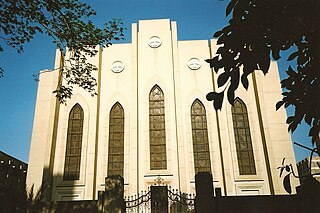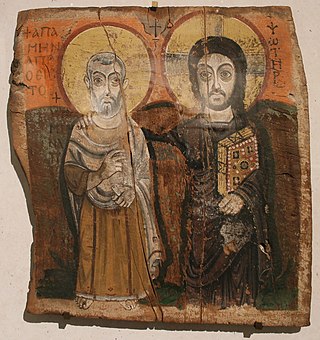
The Coptic Orthodox Church, also known as the Coptic Orthodox Patriarchate of Alexandria, is an Oriental Orthodox Christian church based in Egypt. The head of the church and the See of Alexandria is the pope of Alexandria on the Holy Apostolic See of Saint Mark, who also carries the title of Father of fathers, Shepherd of shepherds, Ecumenical Judge and the 13th among the Apostles. The See of Alexandria is titular. The Coptic pope presides from Saint Mark's Coptic Orthodox Cathedral in the Abbassia District in Cairo. The church follows the Coptic Rite for its liturgy, prayer and devotional patrimony. Adherents of the Coptic Orthodox Church make up Egypt's largest and most significant minority population, and the largest population of Christians in the Middle East and North Africa (MENA). They make up the largest share of the approximately 20 million Christians in Egypt.

Copts are a Christian ethnoreligious group indigenous to North Africa who have primarily inhabited the area of modern Egypt since antiquity. They are the largest Christian denomination in Egypt and the Middle East, as well as in Sudan and Libya. Copts in Egypt account for roughly 5–15 percent of the Egyptian population; Copts in Sudan account for 1 percent of the Sudanese population, while Copts in Libya similarly account for 1 percent of the Libyan population.

The Coptic Catholic Church is an Eastern Catholic particular Church in full communion with the Catholic Church. Along with the Ethiopian Catholic Church and Eritrean Catholic Church, it belongs to the Alexandrian liturgical tradition. Uniquely among the Alexandrian Rite Eastern Catholic liturgies, the Coptic Catholic Church uses the Coptic Rite and the Coptic language in its liturgy; the Ethiopian Catholic Church and Eritrean Catholic Church use the Ge'ez Rite.

Michael I was the 46th Coptic Pope and Patriarch of Alexandria from 743 to 767.
Pope Zacharias of Alexandria, was the 64th Pope of Alexandria and Patriarch of the See of St. Mark.

Rafael was a ruler of the Nubian kingdom of Makuria.
Salomo or Solomon was a ruler of the Nubian kingdom of Makuria.
Qift is a city in the Qena Governorate of Egypt about 43 km (27 mi) north of Luxor, situated a little south of latitude 26° north, on the east bank of the Nile. In ancient times its proximity to the Red Sea made it an important trading emporium between India, Punt, Arabia Felix and the North. It was important for nearby gold and quartzite mines in the Eastern Desert, and as a starting point for expeditions to Punt.

The Arab conquest of Egypt, led by the army of 'Amr ibn al-'As, took place between 639 and 642 AD and was overseen by the Rashidun Caliphate. It ended the seven-century-long Roman period in Egypt that had begun in 30 BC, and widely speaking Greco-Roman period that had lasted about a millennium.

Coptic art is the Christian art of the Byzantine-Greco-Roman Egypt and of Coptic Christian Churches. Coptic art is best known for its wall-paintings, textiles, illuminated manuscripts, and metalwork, much of which survives in monasteries and churches. The artwork is often functional, as little distinction was drawn between artistry and craftsmanship, and includes tunics and tombstones as well as portraits of saints. The Coptic Museum in Coptic Cairo houses some of the world's most important examples of Coptic art.

The Monastery of Saint Anthony is a Coptic Orthodox monastery standing in an oasis in the Eastern Desert of Egypt, in the northern part of the Red Sea Governorate close to the border with the Suez Governorate.

Saint Virgin Mary's Coptic Orthodox Church, also known as the Hanging Church, is one of the oldest churches in Egypt which dates to the third century. It belongs to the Coptic Orthodox Church of Alexandria.
Abu l-Makārim Saʿdullāh ibn Jirjis ibn Masʿūd (d.1208) was a priest of the Coptic Orthodox Church of Alexandria in the thirteenth century. Abu al-Makarim is best known as the author of a famous work entitled History of Churches and Monasteries. This was written around 1200.
Benjamin of Tiberias was a man of immense wealth, who enlisted and armed many soldiers during the Jewish revolt against Heraclius in the 7th century Palaestina province of the Byzantine Empire. The Persian force was joined by Benjamin of Tiberias, who enlisted and armed Jewish soldiers from Tiberias, Nazareth and the mountain cities of Galilee. Together they marched on Jerusalem. Later, they were joined by the Jews of the southern parts of the country; and supported by a band of Arabs, the united forces took Jerusalem in 614 CE. Benjamin was one of the leaders of the revolt, actively participating in the Persian siege and capture of Jerusalem in 614. It is thought that the second leader Nehemiah ben Hushiel was appointed as ruler of Jerusalem.
ʿAlī ibn Sulaymān al-Hāshimī was an eighth-century Abbasid prince. He served as a governor of several provinces, including the Yemen, the Jazirah, and Egypt.
Pbow was a cenobitic monastery established by St. Pachomius in 336-337 AD. Pbow is about 100 km (62 mi) north of Luxor in modern Upper Egypt. It was one of the nine Pachomian monasteries.
Al-Walid ibn Rifa'ah al-Fahmi was a governor of Egypt for the Umayyad Caliphate from 727 to 735.
Abd al-Malik ibn Marwan ibn Musa ibn Nusayr was the last governor of Egypt for the Umayyad Caliphate.

Copto-Arabic literature is the literature of the Copts written in Arabic. It is distinct from Coptic literature, which is literature written in the Coptic language.










